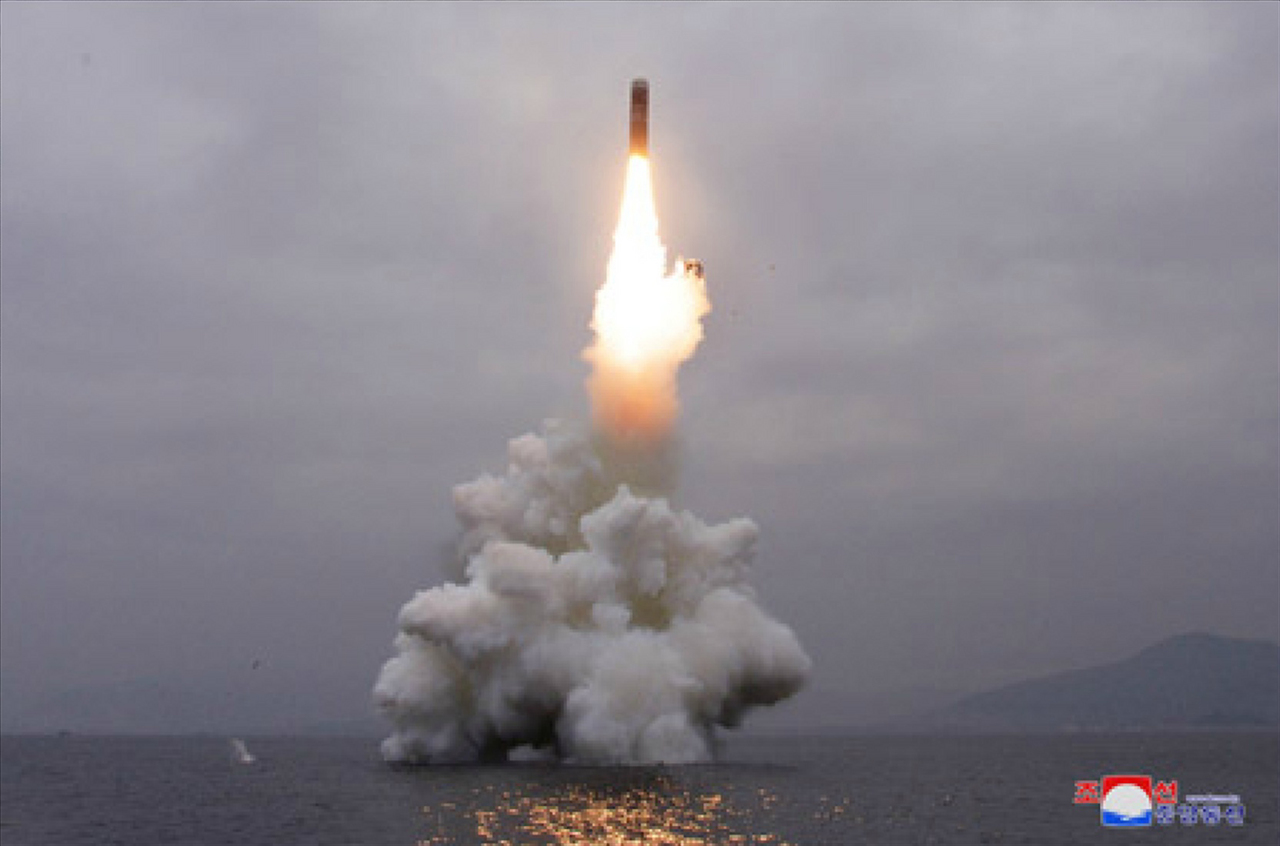North Korea said Thursday that it has successfully test-fired a new-type submarine-launched ballistic missile, boasting that the success "ushered in a new phase" in its self-defense capabilities just two days before resuming nuclear talks with the United States.
The North's Academy of Defence Science succeeded in test-firing the "new-type SLBM Pukguksong-3" in the waters off Wonsan Bay of the East Sea on Wednesday morning, the Korean Central News Agency said, adding that the missile was fired "in vertical mode."
"The test-firing scientifically and technically confirmed the key tactical and technical indexes of the newly-designed ballistic missile and had no adverse impact on the security of neighboring countries," KCNA said.
"The successful new-type SLBM test-firing comes to be of great significance as it ushered in a new phase in containing the outside forces' threat to the DPRK and further bolstering its military muscle for self-defence," the KCNA said, using the acronym of the North's official name, the Democratic People's Republic of Korea.
Leader Kim Jong-un sent "warm congratulations," it said, suggesting he did not attend the testing.
On Wednesday, South Korea's military said that the North fired what appeared to be an SLBM into the East Sea and the missile flew around 450 kilometers at a maximum altitude of about 910 km.
Experts say that the missile could have flown longer if it was fired at an normal angle, not "in vertical mode."
 |
(KCNA via Yonhap) |
Wednesday's launch was the North's 11th weapons test so far this year and the first SLBM test since August 2016, when it test-fired a Pukguksong-1 ballistic missile off the east coast, which flew about 500 km. During the previous 10 rounds of tests, Pyongyang fired only shot-range projectiles.
US President Donald Trump has played down the North's weapons tests involving short-range projectiles, saying that leader Kim is not breaking an agreement that they agreed in their summit in June last year. Trump has not commented on the latest SLBM testing.
Along with its intercontinental ballistic missiles, the North's SLBM program is considered one of the biggest threats to the US and its allies, as it could extend the range of the North's nuclear missiles and such a missile is hard to detect in advance before it emerges from the water.
Though North Korea did not provide other details on the tested weapon, the Pukguksong-3 missile is presumed to have a flight range of 2,000 km or longer, and North Korea is forecast to continue to upgrade it to further extend that, according to experts.
From the North's eastern coastal town of Wonsan, Hawaii is some 7,000 km away and Alaska around 5,000 km, so North Korea may try to make its SLBM secure a range of at least 3,000 km in order to launch it from its sub in the Pacific to target the US mainland.
Experts also paid attention to the design of the new missile, which indicates the North's technical advance.
The Pukguksong-3 missile appears to be larger and longer than the previous version. Different from the Pukguksong-1 missile, the newly developed one also does not seem to have grind fins. As they are used on conventional missiles and bombs to enhance steering and improve precision, their elimination would indicate its flight stability," said Shin Jong-woo from the Korea Defense and Security Forum in Seoul.
He also pointed to its new design, which bears similarity to China's JL-2 SLBM.
"The outward similarity to the Chinese one would mean that North Korea aims to secure an SLBM which can carry multiple warheads," Shin added. The JL-2 SLBM is capable of carrying three to eight warheads.
Wednesday's weapons test appears to be intended to up the ante ahead of its denuclearization talks with Washington scheduled for later this week. Some suggest that it could be intended to express its displeasure with Seoul showcasing its high-tech weapons on the Armed Forces Day a day earlier.
On Tuesday, North Korea's First Vice Foreign Minister Choe Son-hui issued a statement, saying that Pyongyang and Washington agreed to hold preliminary contact on Friday and working-level negotiations on Saturday.
The talks will mark a resumption of the denuclearization process that has been stalled since February's summit between Trump and Kim. The summit fell apart as they failed to iron out differences on the scope of Pyongyang's denuclearization steps and Washington's sanctions relief.
North Korea has urged Washington to come up with a new proposal acceptable to Pyongyang before the end of this year, ramping up its demand for sanctions relief and security guarantees in exchange of denuclearization steps.
Trump recently dismissed John Bolton, his national security adviser known for hawkish view on the North and hinted at seeking a "new method" in denuclearization talks with Pyongyang.
It still remains unclear how far the two countries could go in terms of the scope of Pyongyang's denuclearization.
In a speech at the UN General Assembly session last month, Trump emphasized North Korea must denuclearize in order to tap its "tremendous" economic potential. North Korea has said discussions on denuclearization will be possible only when all threats to the regime are fully removed, apparently referring to security guarantees and sanctions relief from the US. (Yonhap)








